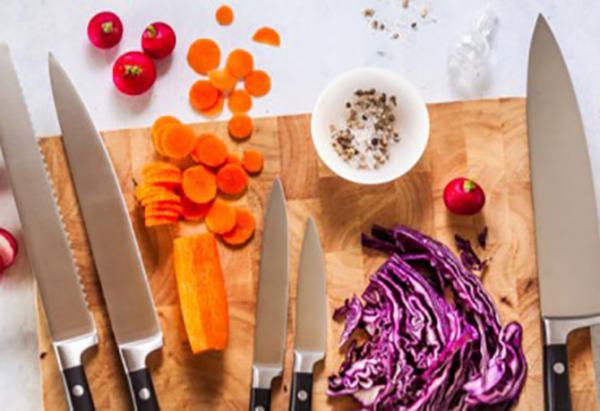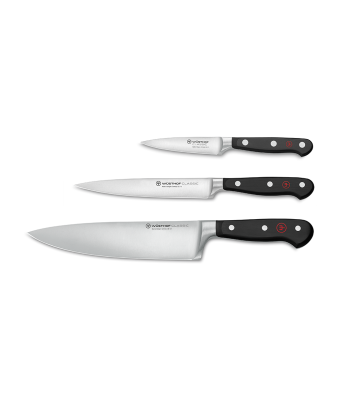Anatomy Of A Kitchen Knife

A blade and a handle - that's all there is to any kitchen knife, right? Wrong. As perhaps the most important tool in your kitchen arsenal, your kitchen knives have an intricate story to tell. All knives may have similar aspects, but beneath all that, the DNA is unique - in fact, different kitchen tasks can call for specific parts of the knife to be used. Are you ready to sharpen your knowledge of the anatomy of a knife?
In this guide:
- The Intro
- The Blade
- The Edge
- The Point
- The Tip
- The Spine
- The Heel
- The Handle
- The Bolster
- The Tang
- The Butt
- Knife Materials
The Blade
You are certainly familiar with this aspect of a knife. It is the main body of the tool, but its size, shape and strength will vary according to purpose. Whatever the style of blade, you must be aware of what is required of your blades characteristics in order to carry out the job precisely. The shape and style of your blade can completely change the way your cut is actioned.
The blade includes various parts – the heel, the spine, the edge, the tip and the point.
There are a few types of blades that any chef should be familiar with:
Straight Edge/Flat Ground – This is the simplest and most common blade edge. It is needed to be extra sharp and clean in order to do its job efficiently. This knife is formed by grinding the blade straight so it tapers to form a razor sharp edge.
Hollow Ground – These blades tend to be ground deep and leave concave sides with a very thin, fragile edge. The edges are created by grinding just below the midpoint of the blade. Since the edge is much thinner, it can be more brittle and easily dulled. Preferable knife for fine cutting such as skinning, preparing sushi or peeling fruit.
Serrated – Often referred to as ‘jagged edged’ or ‘scalloped edge’ these knives feel rough to the touch, with the serrations usually very visible to the eye. This type of knife is great to tear through tough meat or vegetable fibres. A common example of a serrated knife is a steak knife.
Granton Edge – Oval divots are moulded into a Granton Edge blade and usually run along the length. The grooves in the blade create air space between the product and the knife, which makes slicing easier. As a speciality blade, these knives are designed to cut with little resistance.
The Edge
The edge of the knife is where the two sides meet and extend from the heel to the tip. It is the part that you cut with. It should be the sharpest part of the blade as it will usually do most of the work. Maintaining a sharp edge can not only be crucial for maximum effectiveness, but also for user safety.
There are various types of edges to be made aware of, with the two main schools of cutting edges being Western-style and Japanese-style.
V-Edge/Compound bevel – This is the most common edge found in the kitchen and is exactly what it sounds like. The two sides of the blade join together in a V shape. A variation on this is called a compound bevel (or double bevel) which has a large V with a smaller V on top, at the very end. The second V, however, is so small that the human eye cannot see it, but still holds much-needed knife power.
Convex Edge – A particularly elegant edge, the Convex looks similar to a cross-section of an aeroplane wing. It consists of two arcs which curve towards each other and intersect. It can be tricky to sharpen and if not careful can be transformed into a traditional v-edge.
Hollow Edge – While this type of edge is common for hunting, they are a great alternative for an inexpensive butchers knife, but rarely used as a quality kitchen knife. The curve is the opposite direction as a convex.
Chisel Edge – Found traditionally in Japanese cuisine preparation- especially on sushi knives – the chisel edge is extra sharp. One side is usually left flap whilst the other is ground on one side to make a small edge angle and a powerful spike.
The Point
As you would expect, the point is the very top of the blade, where the edges meet. While its not technically always a cutting surface, but it can be used in other ways such as piercing or scoring the surface of the food.
While the point of any knife is usually sharpened to a fine point, there are several types of points, each with a unique shape. Here are just some examples of kitchen knife points:
- Trailing points – A trailing point has an upward curve which provides a larger cutting area (belly) great for slicing or skinning.
- Needle/Dagger Points – A needle-point has a sharply tapered acuminated point. Knives with this point tend to be double-edged and allow you to cut using both sides.
- Spear Points – A spear point is similar to a needle-point in that is is a great choice for piercing. However, it tends to have a stronger point and a smaller belly which is ideal for slicing.
The Tip
Not many people can differentiate between the point and the tip, however, the tip actually sits just below the point. Some people refer to the part as ‘the belly’ and believe it to be a more appropriate term. Because it’s so far from the handle, not much pressure can be applied, however, it is a useful part of the knife for delicate and precision cuts. Pointed tips are ideal for piercing and also cutting small portions, whilst rounded tips are still great for cutting and slicing thinner items.
The Spine
The spine is the top of the blade, directly opposite the edge. This is very rarely used as a cutting surface. The thicker the spine, the more heavy duty the knife tends to be. As an example, a filet knife will be more flexible with a thinner spine whereas a meat cleaver will have a thicker spine to withstand repeated action. The spine is a useful part of the anatomy of a knife as it can be held for better stability when finely choppings nuts or herbs. It can also add strength when slicing harder ingredients such as pumpkin or butternut squash.
The Heel
The heel is the section of the blade which is nearest to the handle itself. It tends to be the strongest part of the tool and is the optimum area to use for shearing through tough ingredients. Generally, the heel is the widest part of the blade and is where you will have the most leverage and control. Some slimmer knives may have no heel at all as the blade is swallowed by the handle.
The Handle
Naturally, the handle is where you will grip the knife. Luckily, most handles are designed with some sort of ergonomics and it is much easier when your knife is comfortable. Some handles are made of two separate pieces that are then clamped around the blade (called scales), but others are a single moulded piece into which the blade is then inserted. Some knives are made of one single piece of metal.
Common materials for handles include plastic, wood, metal, rubber and wood/plastic composites.
Wood – Wood handles cutlery used to be common, but has fallen in popularity now thanks to health inspectors and their food safety concerns. Wood handles knives can often not be as durable and can even trap bacteria.
Stainless Steel – The reason why many chefs prefer stainless steel handles is because they are basically maintenance free. They are durable and easy to clean, and can often have better balance. Perhaps the only downside is their lack of grip when wet.
Plastic – Even within the industry, plastic handles are now one of the most popular handle types. They are easy to clean and hold up well over time. A possible grumble could be the occasional cracks over time due to temperature changes.
The Bolster
The bolster is only found on forged knives and is a thick band of steel which lays between the heel and the handle. It helps with balance and also prevents the user’s hand from the blade area. Furthermore, the added weight from the bolster can provide an aesthetically pleasing and well-crafted knife.
The Tang
The tang is the part of the blade that extends into the anatomy of the handle. Full tang blades are considered to have superior balance and durability with a ‘sub-tang or ‘half-tang much less, but more economic. The tang may be considered as an unimportant part of a knife, but in fact, it is a vital component for not only balance but weight distribution, stability and strength. In some designs, the tang functions as a handle.
The rivets and screws are also a vital part which fixes the tang to the handle. Less expensive designs may forego rivets and attach the handle using resin and epoxy instead.
The Butt
Sometimes referred to as the pommel, the butt is at the very back of the handle. The tang may be seen at the butt. The butt is also a main, supporting component in your knife and forms a downward hook to help position and stabilise your grip on the handle. It is also often used as a pounding instrument, although this is not advised if you want to keep knives in top condition.
Knife Materials
Kitchen knives can be made from a variety of materials, differing in quality and strength. The most common of these materials are:
Stainless Steel
This is a rather cheap metal that will make very affordable knives. However, the blades will need plenty of care as they will dull fairly quickly. While they may need regular sharpening, the blades are fairly resistant to rusting and staining.
Carbon Steel
With a higher carbon content than regular stainless steel, these blades are harder wearing. The carbon in the metal means that the blades will be able to keep their sharp edge better than stainless steel knives.
Damascus Steel
Blades made from Damascus steel are particularly stylish with distinctive patterns that occur naturally from the forging process. This process involves creating a carbon steel core which is then surrounded by a build up of layers of soft and hard stainless steel. This creates an incredibly durable blade which can hold an extremely sharp edge.
Ceramic
Ceramic blades are known for being particularly hard, holding their sharp edge for far longer than most metal knives. In fact these knives are so hard that they can only be sharpened by diamond sharpeners. The material may be incredibly hard, but it is also lightweight, making it popular with some chefs.
Titanium
These knives tend to combine titanium with other materials such as ceramic, silver or even diamond. This creates a remarkably tough blade which, like the ceramic blade, is also lightweight.
When cared for carefully and properly, a set top of quality kitchen knives will last you for years. That’s why it is crucial that you pick the right ones for its purpose and your personal preference. Your kitchen craft can be made perfect the addition of the right tools.
At Kitchen Knives we understand the importance of a high-quality knife collection and are here to provide you with only the best information and products. Don’t hesitate to get in touch with a member of our team if you have any questions.

